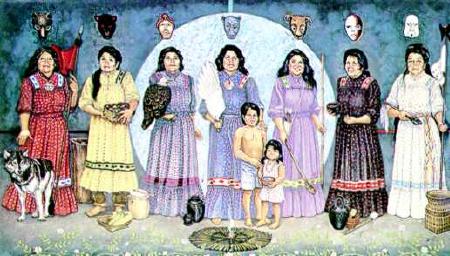|
*Note: Cultural information may vary from clan to clan, location to location,
family to family, and from differing opinions and experiences. Information provided here are not 'etched in stone'.

In a search for order and sustaining that order, the olden Cherokee devised a simple,
yet seemingly complex belief system. Many of the elements of the original system remain today. Although some have
evolved or otherwise been modified, the traditional Cherokee of today recognize the belief system as an integral
part of day-to-day life.
Certain numbers play an important role in the ceremonies of the Cherokee. The numbers four and seven repeatedly
occur in myths, stories and ceremonies. Four represents all the familiar forces, also represented in the four cardinal
directions. These cardinal directions are east, west, north and south. Certain colors are also associated with
these directions. The number seven represents the seven clans of the Cherokee, and are also associated with directions.
In addition to the four cardinal directions, three others exist. Up (the Upper World), down (the Lower World) and
center (where we live, and where ‘you’ always are).
The number seven also represents the height of purity and sacredness, a difficult level to attain. In olden times,
it was believed that only the owl and cougar had attained this level, and since then, they have always had a special
meaning to the Cherokee. The pine, cedar, spruce, holly and laurel also attained this level. They play a very important
role in Cherokee ceremonies. Cedar is the most sacred of all, and the distinguishing colors of red and white set
it off from all others. The wood from the tree is considered very sacred, and in ancient days, was
used to carry the honored dead.
Because of these early beliefs, the traditional Cherokee have a special regard for the owl and cougar. They are
the honored ones in some versions of the Creation story. They were the only two who were able to stay awake for
the seven nights of Creation. The others fell asleep. Today, because of this, they are nocturnal in their habits
and both have night vision. The owl is seemingly different from other birds, and he resembles an old man as he
walks. Sometimes, the owl can be mistaken for a cat with his feather tufts and silhouette of his head. This resemblance
honors his nocturnal brother, the cougar. The owls’ eyes are quite large and set directly in front like a persons,
and he can close one independent of the other. The cougar is an animal whose has screams which resemble those of
a woman. He is an animal who has habits that are very secret and unpredictable.
The cedar, pine, spruce, laurel and holly trees have leaves all year long. These plants, too, stayed awake seven
nights during the Creation. Because of this, they were given special power, and they are among the most important
plants in Cherokee medicine and ceremonies.
Traditionally, the Cherokee are deeply concerned with keeping things separated and in the proper classification,
or category. For example, when sacred items are not in use they are wrapped in deerskin, or white cloth, and kept
in a special box or other place.
The circle is a familiar symbol to traditional Cherokees. The Stomp Dance and other ceremonies involve movements
in a circular pattern. In ancient times, the fire in the council house was built by arranging the wood in a continuous
"X" so that the fire would burn in a circular path.
The rivers, or "Long Man," were always believed to be sacred, and the practice of going to water for
purification and other ceremonies was at one time very common. Today, the river, or any other body of moving water
such as a creek, is considered a sacred site, and going to water is still a respected practice by some Cherokees.
The everyday cultural world of the Cherokee includes spiritual beings. Even though the beings are different from
people and animals, they are not considered "supernatural." They are very much a part of the natural,
or real, world and most people at some point in their lives, have an experience with spiritual beings. One group
of spiritual beings still talked about by many Cherokees, are the Little People. They are invisible unless they
want to be seen. When seen, they look very much like any other Cherokee, except they are very small, and have
long hair, sometimes to the ground. The Little People live in various places, such as rock shelters, caves in the
mountains, laurel thickets, etc. They like drumming and dancing, and they often help lost children. Not only physically
lost, but sometimes saddened children and those who are going through the tough times of growing up. They are also
known to be quite mischievous at times. The Little People need to be dealt with carefully, and it is necessary
to observe the traditional rules regarding them. They don’t like to be disturbed, and they may cause a person who
continually bothers them to become 'puzzled' throughout life. Because of this, traditional Cherokees will not investigate
or look when they believe they hear Little People. If one of the Little People is accidentally seen, or if he or
she chooses to show himself, it is not to be discussed or told of for at least seven years. It is also a common
practice to not speak about the Little People after night fall.
Info provided by the Cherokee Nation Cultural Resource Center
cultural@cherokee.org
|
